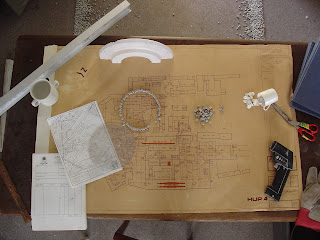Resurrecting
the Obsolete
Research
Residency 1.
RICHARD
LAUNDER
Age of Enlightenment
Starting
Strategies (Sept. 8 - 18th 2012): enacted upon simultaneously
(especially days 1 and 2):
·
assemble all movables which mutely appeal, make note of others not
so easy to move (photo document, write in register)
·
Physically walk thro the buildings and roads, try to get lost and
assemble a mind-map of these (photo document, write in register)
·
Oblique strategy: enter every unlocked door (we were told that we
could enter all doors that were open: in relation to security risk), enter and
move onward until stopped, retrace steps, start again.
These
Situationist approach’s gave a speedy accumulation of site knowledge - the
physical buildings, spaces, levels, inside/outside and importantly, via the
collecting, moving, testing and the observation involved: an overview about the
former employees together with their particular professional areas, jobs,
skills and even some individual personal aspects (of which, more later)
Enabling a psycho-geographic reading.
Procedural
Strategies:
while simultaneously continuing the above, though to a lesser degree:
·
Locate a variety of spaces/objects which ‘push back’ and speak: the emotive
atmosphere of pressure/deadlines, movement, physical work/wear & tear, tools,
plans/maps, reports, unfinished ceramics
·
Particular atmospheres I was stimulated to find:
focused concentration, traces of time passing, dereliction, threads of
connections (internal and external)
·
Hold in mind certain issues: ‘Paths of Desire’, ruins,
walking, archives, psycho-geographies, create rules, Destruction Art,
·
Start to work with these empirically/intuitively articulating the
spaces, the movable materials, background narratives/knowledge gained
·
Be open to: performative/video, sculptural, installation,
/sculpture, photographic, text possibilities and combinations
By
journeying through these I came to proceed with a group of potential projects
which developed in parallel, and often in conversation with each other; they
all moved along at different speeds some clearly needing a lot more
time/concentration, others arriving fairly effortlessly - nice when that
happens.
Research
Residency 2: 9 - 19 March 2013
ROUTEMASTER:
Spode Office
ROUTEMASTER´S Desktop, Walks & Maps
Umbrella
title for a group of interrelated works conceptualised, produced & curated
from the ROUTEMASTER: Spode Office, a physical space, extant Sept. 2013 - Dec.
2013? (Distribution to be negotiated)
·
A contextualised ‘viewing space’ - an office which it is
possible to view into from 4 sides (goldfish bowl like) it becomes a
performative installation, with a potential for guided (limited numbers)
audience to enter and potentially interact (in direct opposition to both the
history of the site) From this HQ, other works are conducted - the balance
between fictive and real office is resolved by the 2 desks inherited in the
room.
The room was staged (originally in Sept. 2012) to convey an atmosphere of
competence, confrontation, on the brink of dis-function/chaos; a maximallist
approach to intense detail, placing layers of suggested narrative, potential
past/future/present actions/events and the files, plans, maps, tools/equipment
(individually doctored), samples, reports, personal items...which are their
alibis. After a year of occupancy,
a new layer of dust, light markings/fadings, together with evidence of recent
activities will become part of the accretion.
ROUTEMASTER: Spode Office: title, came about by being asked directly by Julia Collura
(collaborative partner for a performance work): who’s room is this? What is
this person doing? What is the character of the person whose office this
is?
Staging
/performance texts/sketches, Julia & I will have time on-site in March to
run thro some of our collaborative concepts (sound: the old AEOLIAN grand
piano/costume/progression of site - the potential of a ‘processing
audience’)
Location: office, originally the heart of the factory:
technical personnel, those who found solutions/kept production rolling; 1st
floor of 1950´s Designers block.
ROUTEMASTER:
Spode Office: a selection of
curated on-going works:
·
White on White: performative place/performing
objects: partially finished ceramic plates performing. Needs: editing, staging texts developing sound recordings, more
filming on site, further investigating access to the top round window (via a
trapdoor)
Location: main arterial road connecting the old front of
factory (admin. /sales/museum) to the various production areas, Designers
block, 1950´s functionalist building; all brickwork painted matt white, plates
are matt white.
White on White: performance video still
·
Topography of
Routemaster´s desktop and Walks: A found partial plan of the site with a circle marked
out,
no information about why. Use
to investigate the circle as a derive, attempt to walk it through the labyrinth site (rule: follow the
circle as closely as possible, only enter through open doors) Map this out
using various tools/materials on a large scale full plan of the factory
(found), placed on the Routemaster´s desk- leave as evidence of activity (frozen in time). Needs: Allocate time for further walking and
collecting approaches: investigate sound recording/ register opportunities.
Paths of Desire
·
bone to bones: a performing story of
material and manufacture involving ruin/climate-erosion/decay: nature; contra
protection/ shelter/refinement: civilisation; in relation and as comment to the
contemporary economic and political position of materialist/consumer culture. A
noble savage for our times? From a quasi archeologic/geologic/construction site
position.
Proposed scale: two square floor areas covered by an echo of galvanised
corrugated roofing. (Approx. 2 m x 2m)
with guttering exchanging the rain & leak waters. Installation to be constructed
in March, then needs to be left in-situ to weather until the biennial.
Documentation during erosion process, footage may become a video. Location: leaking roof is
located and a pipeline route to the nearby outside courtyard area.











.jpg)
.jpg)
.jpg)
.jpg)
.jpg)




































